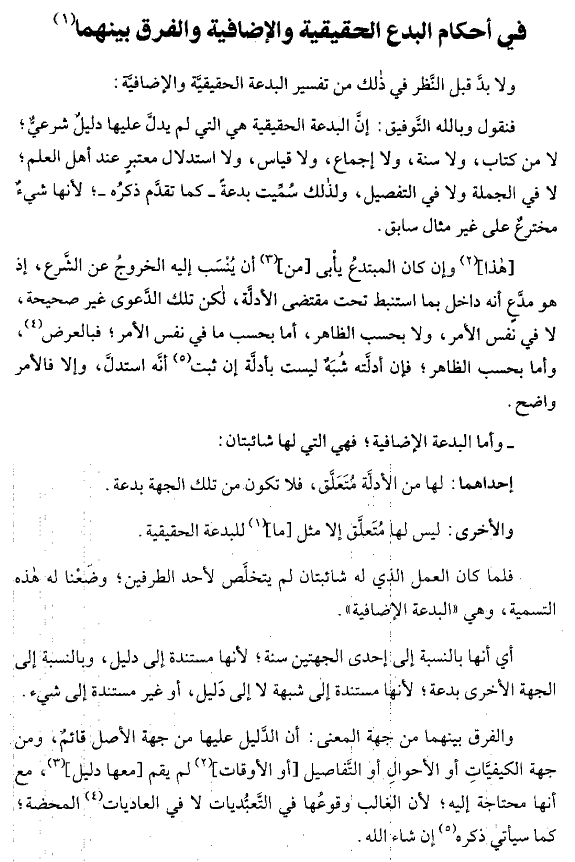Bidah.Com
Posted by Abu.Iyaad on Wednesday, July, 13 2011 and filed under Foundations
Key topics: Bidah Haqiqiyyah • Bidah Idafiyyah • Al-Shatibi • Al-Shaatibee

Imaam al-Shatibi said in his excellent book al-I'tisam (tahqiq M. Salman, Maktabah Dar al-Tawhid, 2/127-128), clarifying the different types of innovation:

Regarding the Rulings Pertaining to Proper innovation and Relative innovation and the Difference Between Them Both
Before we look into that it is necessary to look at the explanation al-bidah al-haqiqiyyah (proper innovation) and al-idafiyyah (relative innovation).
So we say and with Allaah lies success: The bidah haqiqiyyah (proper innovation, in every sense of the word) is that which is not indicated by any Shariah evidence, neither from the Book, nor the Sunnah, nor ijma' (consensus), nor qiyas (analogy) and nor any accepted evidence with the people of knowledge, neither in the generality nor in the detail. For this reason it is labelled "bidah" - as has been mentioned previously - because it is something invented without any prior example.
This is the case even if the innovator refuses that he should be ascribed with exiting from the (confines of) the Shariah, since he is claiming that he is (still) within it on account of what he has deduced upon the requirements of the evidences. However, that claim is not sound, neither in the affair in and of itself, and nor from what is apparent. As the affair in and of itself, then this is known by looking at it through (the evidences) and as for what is apparent, then his evidences are but doubts, they are not evidences, even if it is established that he has brought evidence, otherwise, the affair is clear.
And as for the bidah idafiyyah (relative innovation) then it has two elements to it:
The first: It has a connection from the evidences, hence from that angle it is not an innovation. The second: It does not have any connection with the evidences except what there is for the bidah haqiqiyyah (in other words, no connection at all).So when this action which has two elements to it is never devoid of one of the two affairs, we have given it this label of 'al-bidah al-idafiyyah.' Meaning that in relation to one of the two angles, it is sunnah, because it is supported by evidence, and in relation to the other angle, it is bidah, because it is [either] supported by a doubt (shubhah), not upon evidence, or it is not supported by anything.
And the difference between them in terms of meaning is: That the evidence for it (bidah idafiyyah) from the angle of the foundation (asl) is established. And from the angle of the details (kaifiyyaat) or states (ahwaal) or particulars (tafseelaat), or times (awqaat), no evidence is established for it despite the fact that it is in need of (evidence) because most of (this type) occurs in the matters of worship, not in the pure customary matters, as will be mentioned shortly inshaa'Allaah.
It is important to note that the contemporary Sufi grave-worshippers and other than them from the innovators try to deceive and confuse between what is bidah idafiyyah (relative innovation) - which is what they are upon, and what they call the people to - and between other matters which a minority of scholars include within the label of "good innovation" but who are merely using this label from the purely linguistic point of view in relation to matters of beneficial public interest (maslahah mursalah). Refer to these articles for more on this:
- Innovation Is of Two Types, Haqeeqiyyah and Idaafiyyah: Read article
- Understanding Matters of public interest (al-masalih al-mursalah) Read article